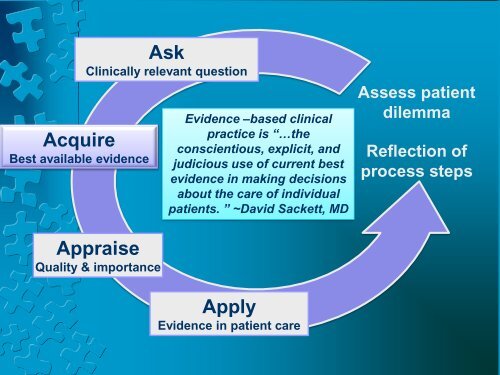How to Find the Evidence
How to Find the Evidence How to Find the Evidence
AcquireBest available evidenceAskClinically relevant questionEvidence –based clinicalpractice is “…theconscientious, explicit, andjudicious use of current bestevidence in making decisionsabout the care of individualpatients. ” ~David Sackett, MDAssess patientdilemmaReflection ofprocess stepsAppraiseQuality & importanceApplyEvidence in patient care
- Page 2 and 3: Nancy Kime, DCKaren Goodell, M.A.
- Page 4 and 5: Finding the EvidenceWhat?Why?• To
- Page 6 and 7: Finding the EvidenceUsefulness = Re
- Page 8 and 9: 1. Filtered Summaries• Meta-analy
- Page 10: 2. Original ResearchArticles• Ran
- Page 13 and 14: 2. Original ResearchArticles• Pub
- Page 15 and 16: 4. Books• Depends on the type of
- Page 17: Search Strategy• Subject Headings
- Page 29 and 30: How do I keep up todate???
- Page 31 and 32: Table of contents ofrelevant journa
- Page 33 and 34: PICO• What do you want to know?
- Page 35: Resources• w3.palmer.edu/ctlpower
AcquireBest available evidenceAskClinically relevant question<strong>Evidence</strong> –based clinicalpractice is “…<strong>the</strong>conscientious, explicit, andjudicious use of current bestevidence in making decisionsabout <strong>the</strong> care of individualpatients. ” ~David Sackett, MDAssess patientdilemmaReflection ofprocess stepsAppraiseQuality & importanceApply<strong>Evidence</strong> in patient care
Nancy Kime, DCKaren Goodell, M.A.•Master’s in Library Science,specializing in medical librarianship
<strong>Find</strong>ing <strong>the</strong> <strong>Evidence</strong>:Where can I find reliableand useful answers <strong>to</strong> myclinical questions?Ms. Karen GoodellDr. Nancy KimeDr. Lia Nightingale
<strong>Find</strong>ing <strong>the</strong> <strong>Evidence</strong>What?Why?• To keep up-<strong>to</strong>-date• To answer clinical questions
<strong>Find</strong>ing <strong>the</strong> <strong>Evidence</strong>Downloaded from flickr.com/pho<strong>to</strong>s/will-lion/2595497078. Used with permission byCreative Commons License
<strong>Find</strong>ing <strong>the</strong> <strong>Evidence</strong>Usefulness = Relevance X Validity ↑Work ↓Relevance = applicability <strong>to</strong> your patien<strong>to</strong>r your <strong>to</strong>picValidity = quality of <strong>the</strong> researchRosser, W., Slawson, D. & Shaughnessy, A. Information mastery: <strong>Evidence</strong>-based familymedicine, Vol 1, London: B.C. Decker, 2004.
MetaanalysisSystematicreviews1. Filtered summariesRandomized controltrialsCohort studiesCase-controlled studies2. OriginalresearcharticlesCase study/Case seriesAnimal research or labora<strong>to</strong>ry studies3. Websites4. Books
1. Filtered Summaries• Meta-analysis• New statistical interpretation of results fromseveral original research articles• Systematic review• Overview of multiple research articlesusing explicit & reproducible searchstrategies
1. Filtered Summaries• DynaMed• National Guideline Clearinghouse –www.guidelines.gov• TRIP database – www.tripdatabase.com• Natural Standard Database
2. Original ResearchArticles• Randomized control trials• Placebo-controlled, double blind studies• Cohort studies/Case-controlled trials• Observational• Compares those with disease <strong>to</strong> thosewithout (case-control)• Compares those exposed <strong>to</strong> those without& determine if disease develops over time(cohort)
2. Original Research• Case study/seriesArticles• Detailed report of symp<strong>to</strong>ms, diagnosis,treatment and follow-up of a single patient(case study) or several patients (caseseries)• Animal/Lab research
2. Original ResearchArticles• PubMed Clinical Queries• TRIP database –www.tripdatabase.com• Google Scholar –http://scholar.google.com
3. Websites• eMedicine – www.emedicine.com• Medscape – www.medscape.com• .org and .edu websites are also helpful
4. Books• Depends on <strong>the</strong> type of informationneeded• Background information – basic reference• Symp<strong>to</strong>ms – e.g. Netter’s OrthopaedicClinical Examination• Treatment – e.g. Conn’s Current Therapyor Souza’s Differential Diagnosis andManagement for <strong>the</strong> Chiroprac<strong>to</strong>r
Search Strategy• Analyze <strong>the</strong> question for main concepts• Think of synonyms for <strong>the</strong> mainconcepts• Think of alternative spellings,abbreviations, and multiple endings• Use subject headings for <strong>the</strong> database– usually gives more focused resultsthan a keyword search
Search Strategy• Subject Headings – PubMed and manymedical databases use Medical SubjectHeadings (MeSH)• These can be searched throughPubMed
Screen shot of
<strong>How</strong> do I keep up <strong>to</strong>date???
Push vs. PullAlerts – sent directly <strong>to</strong> your inbox• DynaMed (Available through PalmerLibrary’s Databases page)• BMJ <strong>Evidence</strong> Updates:http://plus.mcmaster.ca/<strong>Evidence</strong>Updates
Table of contents ofrelevant journals:(Access all <strong>the</strong>se through PalmerLibrary’s A-Z list)• Chiropractic and Manual Therapies• JMPT• Manual Therapy• Spine
Patient Case• Your patient is a 67 year old Caucasianfemale. She is concerned with a recentdiagnosis of osteoporosis and wants yourinput. Will her new schedule of walking<strong>the</strong> mall 3x weekly at a moderate pace beenough <strong>to</strong> slow or reverse <strong>the</strong> effects ofher osteoporosis.
PICO• What do you want <strong>to</strong> know?• Questions about diagnosis/diagnostictests• Questions about <strong>the</strong> condition• Common treatments• Specific question <strong>to</strong> guide advise <strong>to</strong>patient (application of <strong>the</strong> data)
Small Group Activity• Create a PICO• Indicate which database(s) would bemost useful• Indicate which search terms will you use
Resources• w3.palmer.edu/ctlpowerpointsevidence-based practice web sites• Library Serviceshelp with literature searcheshelp researching clinical questionsone-on-one database tu<strong>to</strong>ring



